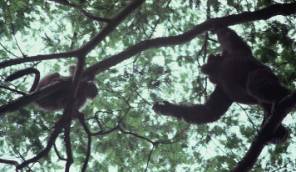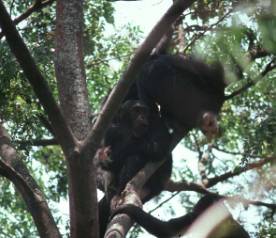 During the early and mid-1990s, I conducted postdoctoral research on the ecological relationship between chimpanzees and the red colobus monkeys that are their favorite prey in Gombe National Park, Tanzania. Although the fact that chimpanzee hunt and relish meat was well known, the details of hunting were poorly understood. The main mammalian prey of chimpanzees is red colobus monkeys at all sites where the two co-occur. By studying two colobus groups and also following enough chimpanzees parties to see 120 encounters between the two species, I was able to test hypotheses about 1)the effects of predation on colobus behavior, ecology and demography, 2)the causes of chimpanzee hunting, and 3)the influence of chimpanzee hunting on colobus social behavioral strategies.
During the early and mid-1990s, I conducted postdoctoral research on the ecological relationship between chimpanzees and the red colobus monkeys that are their favorite prey in Gombe National Park, Tanzania. Although the fact that chimpanzee hunt and relish meat was well known, the details of hunting were poorly understood. The main mammalian prey of chimpanzees is red colobus monkeys at all sites where the two co-occur. By studying two colobus groups and also following enough chimpanzees parties to see 120 encounters between the two species, I was able to test hypotheses about 1)the effects of predation on colobus behavior, ecology and demography, 2)the causes of chimpanzee hunting, and 3)the influence of chimpanzee hunting on colobus social behavioral strategies.
 Together with other field studies of chimpanzees predatory behavior (Boesch and Boesch, 1989; Mitani and Watts, 2001), I was able to address both social and ecological influences on the pattern of hunting, and on the long term effects of hunting on colobus social evolution.
Together with other field studies of chimpanzees predatory behavior (Boesch and Boesch, 1989; Mitani and Watts, 2001), I was able to address both social and ecological influences on the pattern of hunting, and on the long term effects of hunting on colobus social evolution.
Why do chimpanzees hunt ? There is an energetic/nutritional bottom line clearly demonstrated for hunting at multiple study sites, but social factors just as clearly also influence hunting. The particular forest ecology, season, alternative food availability, demographic structure of both chimpanzee and colobus populations, and opportunities for social strategizing, all clearly influence chimpanzee hunting. In Chimpanzee and Red Colobus I outlined at least 16 factors that come into play that predict hunting.

The results of my Gombe work were also useful to paleoanthropologists and archaeologists to model how and why early hominids may have obtained and use meat. We know that meat became an increasingly important part of the diet by about 2.5 million years because we find stone tools in the fossil record. Before that time, proto-hominids were no doubt eating meat as well, but without any archaeological record, living apes offer a window onto past behavior.
This work was conducted with the help of the Gombe Stream Research Centre, and the support of the Tanzanian government, National Geographic Society, National Science Foundation, L.S.B. Leakey Foundation, and Fulbright Foundation.
Selected publications on chimpanzee hunting ecology/meat-eating and human evolution.
Finch, C.E. and C.B. Stanford.
Meat-adaptive genes and the evolution of slower aging in humans. Quarterly Review of Biology 79: 1-50.( in 2004)
Stanford, C.B. and H.T. Bunn (editors)
Meat-eating and Human Evolution. Oxford University Press.(in 2001 )
Stanford, C.B.
A comparison of social meat-foraging by chimpanzees and human foragers. In Meat-eating and Human Evolution (C. Stanford and H. Bunn, eds), pp. 122-140. Oxford University Press. (in 2001)
Plummer, T. and C.B. Stanford.
Analysis of a prey bone assemblage made by wild chimpanzees in Gombe National Park, Tanzania. Journal of Human Evolution 39: 245-265.(in 2000 )[.pdf]
Stanford, C.B.
The Hunting Apes: Meat-eating and the Origins of Human Behavior. Princeton University Press.(in 1999)
Stanford, C.B. and C.H. Janson (editors).
Predation and Primate Social Systems. Behaviour 135: 389-533.( in 1998 )[.pdf]
Stanford, C.B.
Predation and male bonds in primate societies. Behaviour 135: 513-533.(in 1998 )[.pdf]
Stanford, C.B.
Chimpanzee and Red Colobus: The Ecology of Predator and Prey. Harvard University Press.(in 1998)
Stanford, C.B.
The hunting ecology of wild chimpanzees; implications for the behavioral ecology of Pliocene hominids. American Anthropologist 98: 96-113.(in 1996)[.pdf]
Stanford, C.B.
The influence of chimpanzee predation on group size and anti-predator behaviour in red colobus monkeys. Animal Behaviour 49: 577-587.(in 1995)[.pdf]
Stanford, C.B.
Chimpanzee hunting behavior and human evolution. American Scientist 83 (3): 256-261. ( in 1995)
Stanford, C.B., J. Wallis, E. Mpongo and J. Goodall.
Hunting decisions in wild chimpanzees. Behaviour 131: 1-20.( in 1994 )[.pdf]
Stanford, C.B., J. Wallis, H. Matama and J. Goodall.
Patterns of predation by chimpanzees on red colobus monkeys in Gombe National Park, Tanzania, 1982-1991. American Journal of Physical Anthropology 94: 213-228.[.pdf]